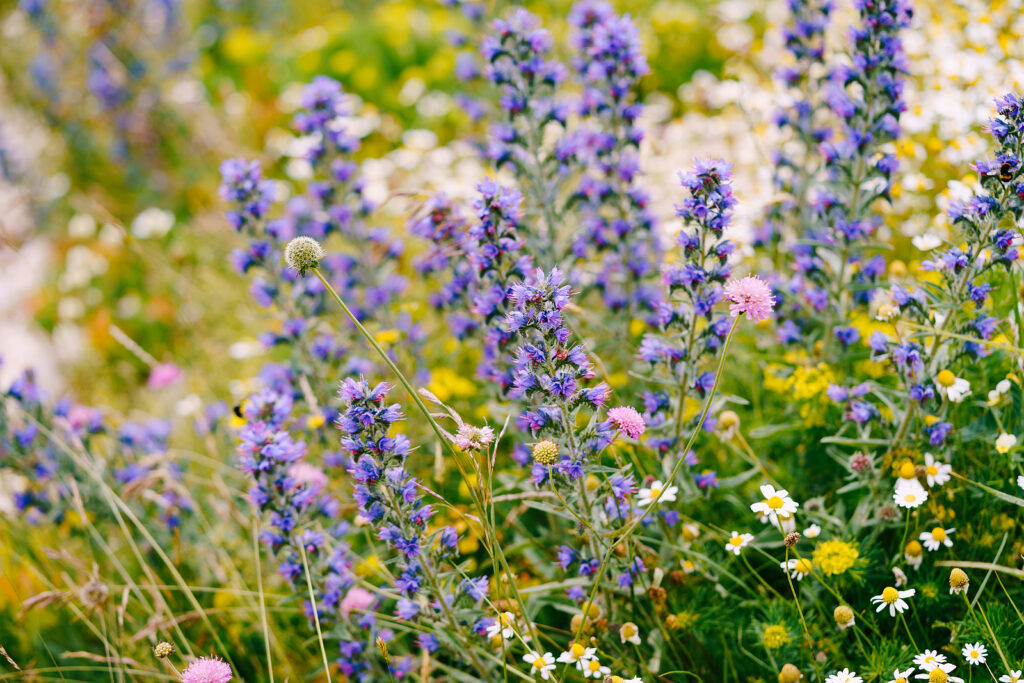Echium — commonly called Pride of Madeira — is a genus of showy perennials and biennials native to the Mediterranean. They bear panicles of bell-shaped flowers in shades of blue, lavender, purple, rose, or white. Where not hardy Echium can be grown as annual. Echiums are colorful additions to annual, mixed, or herbaceous borders. They can also be grown in containers.
Two members of the Echium genus are often grown in gardens. Echium candicans–commonly called Pride of Madeira–is a woody-based biennial that bears dense cylindrical panicles to 12 inches (30cm) long of narrowly funnel-shaped white or bluish flowers from spring to summer. It grows 5 to 8 feet tall (1.5-2.5m). Echium vulgare–commonly called viper’s bugloss–grows just 12 to 18 inches (30-45cm) tall and bears bell-shaped flowers in shades of blue, lavender, purple, rose, or white; the flowers are just a half-inch across.
Echiums can be set in the garden or seeds sown as soon as the danger of frost is past. They will begin flowering as early as three months after sowing. In frost-free regions, seeds can be sown outdoors in the fall as well as in the spring. Fall-sown seeds will blossom at least a month earlier than those started in the spring.
Get to know Echium
- Plant type: Pernnials, biennials, annuals
- Growing zones and range: Zones 3-11 depending on the variety
- Hardiness: Hardy to Zone 9
- Height and width: Varies with species from 12 inches (60cm) to 8 feet (2.5m) tall
- Foliage: Bristly-hairy usually stalkless leaves
- Flowers: Panicles or spikeds of roughly funnel-shaped, sometimes bell-shaped flowers
- Flower colors: Blue, purple, yellow, white or red — see varieties
- Bloom time: Summer
- Uses: Mixed herbaceous border, containers
- Common name: Pride of Madeira
- Botanical name: Echium
- Family name: Boraginaceae
- Origin: Canary Islands, Mediterranean

Where to plant Echium
- Grow Echium in full sun.
- Grow Echium in moderately fertile, well-drained soil. Soil too rich will discourage flower formation.
When to plant Echium
- Set container-grown perennial Echium in the garden in spring or autumn.
Planting and spacing Echium
- Space Echium according to species, from 12 inches (30cm) to 5 feet (1.5m) apart.
How to water and feed Echium
- Water Echium to keep the soil just moist. Water sparingly in winter.
- Echium will benefit from a very low or mild all-purpose fertilizer such as 5-5-5 in spring
Echium care
- Where Echium is marginally hardy, protect perennial species in the garden with horticultural fleece in winter.
- All parts of Echium may cause mild stomach upset if ingested; contact with foliage may irritate skin.
Echium pests and diseases
- Slugs may attack young growth.
Echium propagation
- Sow seed of perennial and biennial species at 55° to 61°F (13°-16°C) in summer; overwinter seedlings at 41°-45°F (5°-7°C).
- Sow seed of annuals in the garden in sprig.
- Root semi-ripe cutting fo shrubby perennials in midsummer.
Echium varieties to grow
- Echium candicans, syn E. fastusoum, Pride of Madeira. Open, rounded, woody-base biennial with lance-shaped leaves; grows 5 to 8 feet tall; bears dense cylindrical panilces to 12 inches long of narrowly funnel-shaped white or bluish white flowers. Hardy to Zone 9.
- E. plantagineum. Upright annual or biennial grows to 24 inches tall and half as wide; lance-shaped leaves; bears cylindrical panicles to 12 inches long of funnel-shaped red to blue-purple flwoers. Hardy to Zone 10.
- E. vulgare, blueweed, viper’s bugloss. Bushy, upright, bristly biennial; grows 24 to 36 inches tall; narrow lance-shaped leaves; dense spikes 12 inches long of broadly bell-shaped flowers; can be grown as an annual border flower. Hardy to Zones 3-8.















